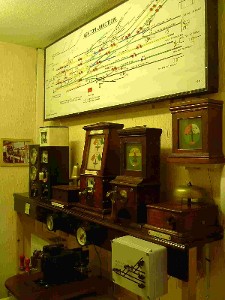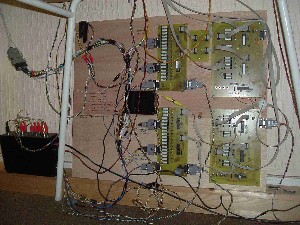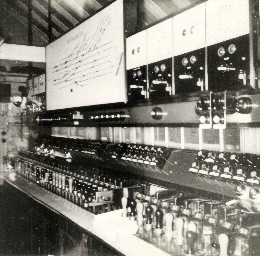Ashton Junction simulation
The most complicated simulation I've built so far is simplified version of Ashton Junction, which was at Guide Bridge on the former GCR main line between Sheffield and Manchester. The prototype Ashton Junction was opened in 1909 as part of the GCR's resignalling between Newton and Ardwick. These boxes were an early example of power signalling using compressed air. The pneumatic signalling was taken out of use in 1985, when the area was resignalled.
The illuminated diagram is a full size replica, prepared using a copy of the original diagram. I have used an assortment of GCR / LNER / BR block instruments, of the types to be found in signal boxes along the Woodhead route. I have even managed to incorporate two pneumatic draw slides to operated the home signals! I improvised a small panel to do the remainder of the route setting. At present, the simulation only includes the fast lines to Stockport Junction, the goods and main lines to Guide Bridge East, and the branch to Guide Bridge North. In effect, I have simulated a double track junction, which splits three ways going east. But this still gives an interesting layout to operate! It does not include the slow lines to Stockport Junction, nor the down slow and down goods No 2 from Guide Bridge East, nor any of the siding connections. It may be possible to add some of these at a later date. In 1983 the slow lines to Stockport Jn were taken out of use - so it could be said there is some historical justification for my configuration. The electronics which run the simulation are hidden under the table - you can see them in the picture at right! This 'rat's nest' of wiring is the old version of the electronics. The new modules are much tidier, but work in just the same way. The two boards on the right each simulate two adjacent block posts (four in total), whilst those on the left look after the illumination of the track circuit lamps. And here is a picture of the real Ashton Junction, probably taken about 1970. You can clearly see the 48 slide pneumatic frame. On the block shelf are rather unusual block instruments, which were to be found in most of the pneumatic boxes in this area. They were installed in the 1950's when the line was electrified, and the block indications are given by coloured lamps set into a panel, rather than the more usual moving needles.


